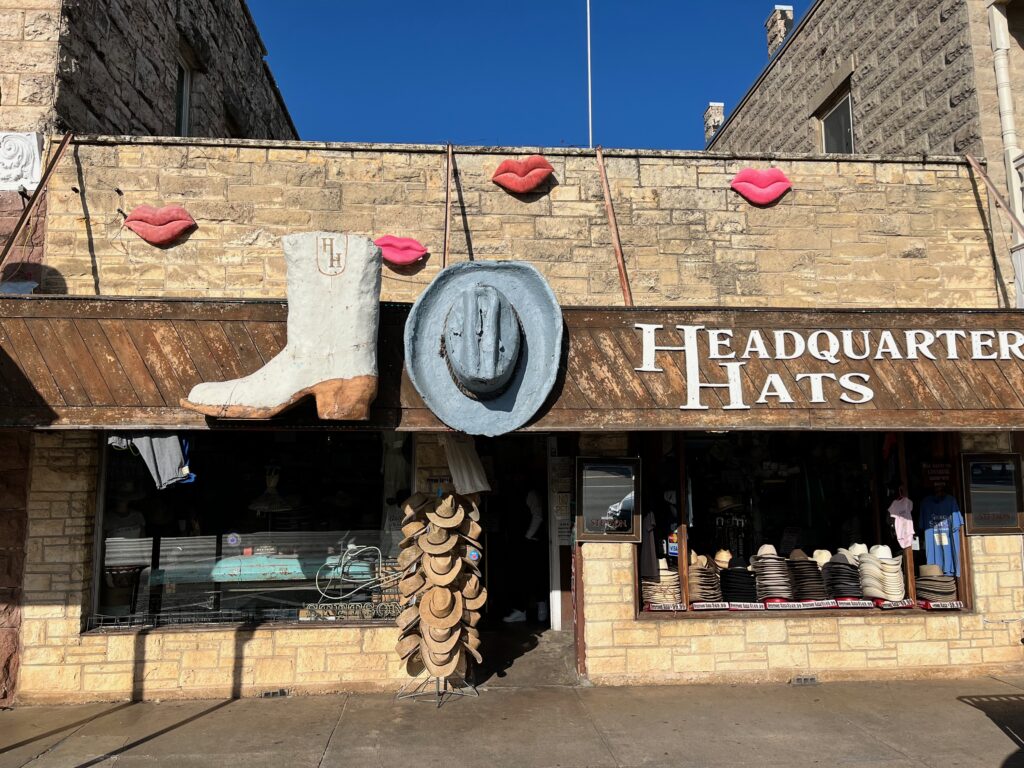
Headquarters Hats in Fredericksburg is one of the more popular hat-and-boots shops in the Texas Hill Country. Photo by Mark Orwoll
By Mark Orwoll,
No wagons waited in Indianola. No food, supplies, shelter, guides, nor oxen to pull the nonexistent wagons.
The year was 1844. Stranded on the shingle shore were a motley gaggle of second sons, reprobates, poor relations, failed merchants, their dispirited wives, and unnerved offspring, all of whom had come to Texas for salvation. There was no chance for them, no living to be had in the assorted dukedoms and principalities of what would become a united Germany. To them, Texas was the Promised Land.
Or so they’d been told.
That motley group of 300 paid the equivalent of a year’s wages for the promise of 320 acres for a family (160 acres for a single man) and help to build a house. Those yeomen and dreamers, absconders and remittance men set sail from Bremerhaven and Antwerp for the new Republic of Texas. During their months-long ocean voyage, they suffered seasickness, tight quarters, and death, only to arrive midway down the Gulf coast of Texas at Indianola.
Today Indianola is a ghost town much of it underwater. The wind doesn’t whistle over Indianola it hisses. What remains of the settlement is surrounded by swamps hardpan roads hot enough to fricassee an armadillo, and fishermen’s cottages raised on 15-foot pillars to avoid the frequent flooding.
When the German castoffs pulled into the port’s soupy waters 180 years ago Indianola was even less glamorous. The entire misadventure promised to be a complete disaster. But they couldn’t go back says Evelyn Weinheimer 80 a descendant of émigrés and a longtime docent at the Pioneer Museum in Fredericksburg. “They’d already spent all their money, How could they go back?”
Still, the travelers remained confident. After all they had as their leader Prince Carl of Solms-Braunfels a handsome, wealthy, earnest, and elegantly mustachioed aristocrat who would soon prove to be the most inept, clueless organizer ever to set foot in the Lone Star Republic.
Confused, scared, and directionless, ravaged by cholera with faces swollen from constant mosquito bites and burned by the sun they set off—some in borrowed rattletrap wagons, many on foot—while others remained behind in shallow graves soon to be dug up by wolves.
Welcome to the Texas Hill Country.
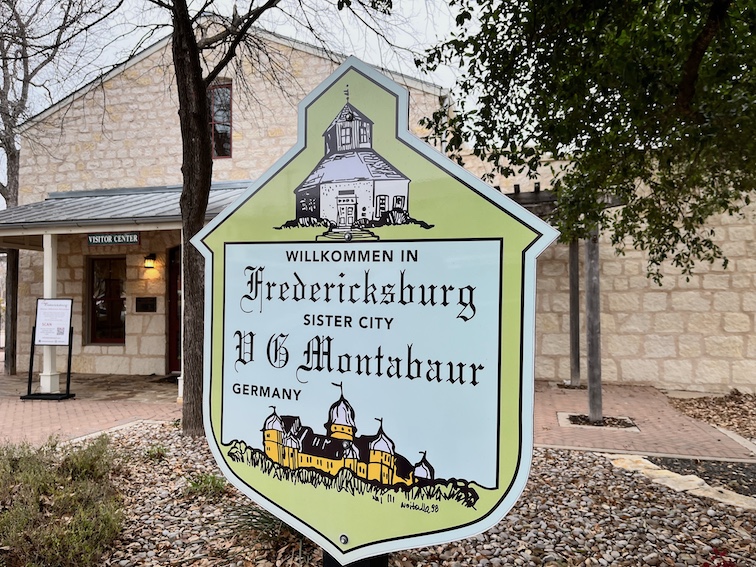
Why Visit Texas’ Hill Country Today
Despite their dubious beginnings, the settlements between Austin and San Antonio 80 miles apart in south-central Texas, now form one of the most attractive and historic regions in the entire state. The Hill Country young families yearn to move there for the good schools and a breezy lifestyle Chocolate shops, cast-iron-pan factories, and gourmet-salsa-makers thrive. Nouveau-Italian restaurants, hat-and-boot boutiques, and yuppified “saloons” do a land-office business. And tourists are thicker than fleas on a lazy possum you’ll find scads of them (tourists, not fleas) in Fredericksburg which bills itself as the most German city in Texas.
On the town’s city limits signs the population is given as eleven thousand two hundred and fifty-seven says David Schafer an author, historian, and driver of the Fredericksburg Trolley tour bus. We get about 1.5 million visitors annually around 25,000 of them show up each year to the town’s Oktoberfest celebration. Fredericksburg has a Texas heart and a German soul. I’m sure some marketing person came up with that he laughs “but it’s true.”
Down in German-settled Gruene (pronounced Green) 75 miles southeast, out-of-town couples do the two-step at the barnlike Gruene Hall the oldest dancehall in Texas, where everyone who’s anyone in country music has played from Merle Haggard and Willie Nelson to the current up-and-comers. Across the Guadalupe River from Gruene, travelers drop by the 154-year-old Phoenix Saloon in New Braunfels for a pint of Lone Star, a bowl of red chili (no beans), and a taste of old-Texas nostalgia. (Chili powder is alleged to have been invented in its back room in 1895). Over in Boerne (pronounced Bernie), also founded by German settlers, visitors stroll past the boutiques, craft breweries and antique emporiums along the mile-long Main Street, which the gemütlichkeit-minded city fathers have craftily named Hauptstrasse.
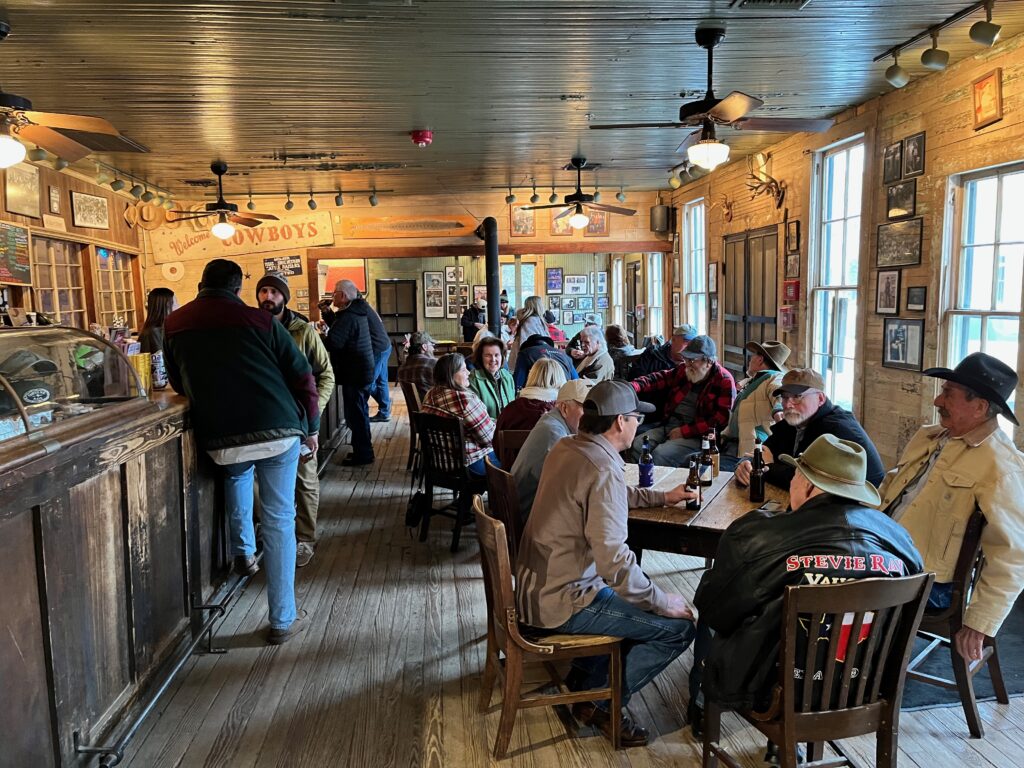
Good old boys (and gals) knock back a few Lone Stars at Gruene Hall before the night’s music begins. Photo by Mark Orwoll
If you enjoy the schmaltz, lift a stein, wolf down a bratwurst, and chuckle at the Wilkommen signs on chichi gift stores. Take a look around and consider that all of this came from nothing but Teutonic determination and the constant threat of Comanches burning down your shack, putting an arrow in your thigh, and possibly running off with your youngest child. At this point these towns take on a different atmosphere.
Hill Country, as pretty and sanitized as it may be isn’t a tourist trap It’s the heart of Texas history.
Who Built the Hill Country?
People came to Texas in the 1840s and 50s. At first the population mainly comprised indigenous people (primarily the Comanches) Hispanics who had lived there for centuries, and Americans from other states and regions. Eventually came Italian stonemasons. French grifters by way of New Orleans, Swedish carpenters and displaced Spanish rancheros from Mexico looking to establish a new life but the Germans stood out.
South-central Texas was built on the shoulders of German immigrants between Austin and San Antonio on rolling hills bursting with bluebonnets, black-furrowed live oaks, and lazy green rivers that run through yellow limestone banks, German was the predominant nationality. They were the shopkeepers, farmers, bankers, and millers who kept early Texas society functioning. At least two German immigrants died as defenders of the Alamo in 1836. The German legacy is still apparent throughout this stretch of Texas.
By dint of industriousness, abetted by a close-knit community that lent the settlers a reliable social infrastructure these deportees persevered and succeeded. The names of their settlements tell the tale among them Luckenbach (its country-hippie motto is “Everybody is somebody”), suburban Niederwald, tiny Bergheim (population app 1200), shopping mecca Boerne, country-music center Gruene, and Friedrichsburg, later Americanized to Fredericksburg and named for Prince Friedrich of Prussia.
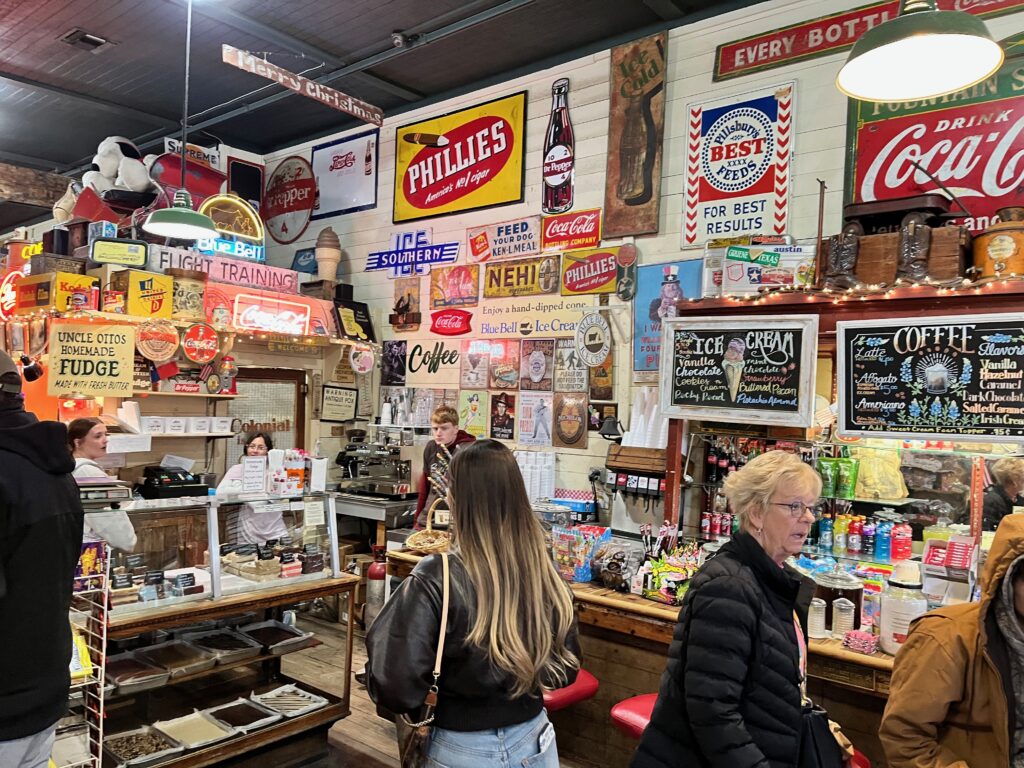
Customers come to the Gruene General Store for snacks and souvenirs. Photo by Mark Orwoll
Prince Carl and the Adelsverein
Located on the site of the Adelsverein (the 1841 headquarters of the Society for the Protection of German Immigrants) the Sophienburg Museum and Archives was established in 1933 to curate the thousands of documents and historical belongings donated by the families of the city’s pioneers over the years. As a research center the Sophienburg has catalogued the genealogies of more than 500 German-settler family names. The archived photo files contain more than 5,00,000 images, plus an immense oral history collection, census and burial records, and local German-language newspapers as far back as 1852. The Sophienburg is one of the most important repositories of Texas-German history in the state (or anywhere else). Casual visitors will enjoy the historical dioramas serious Texas scholars will be in paradise.
Just 30 miles northeast of San Antonio, Neu-Braunfels (as it was originally called) takes its name from the German city of Braunfels, north of Frankfurt where in 1841 you might have found Prince Carl of Solms-Braunfels in his family castle Schloss Braunfels gazing languidly out a stone-encased window and wondering what was the meaning of his overly privileged life. When he was invited into the Adelsverein scheme to send (mostly impoverished) German settlers to the Elysium called Texas, he readily joined in.
Aristocratic investors hoped to profit from trading with and supplying the settlers. Moreover, immigration might start the German colonization of the New World leading to even greater business opportunities. The youthful Prince Carl was quickly named the Commissioner-General and volunteered to lead the first shipload of Adelsverein pilgrims.
At the Sophienburg Museum (named for Prince Carl’s wife Sophia) docent Mark Altenhoff describes how the new arrivals trudged 152 miles for months over harsh terrain yet were still more than 100 miles from their land grant. Prince Carl bought the attractive and fertile land where they’d come to rest and decided to create a way station for those who came later. But many of the new arrivals decided to go no farther they were given a half-acre plot for a house in the new town and 10 acres nearby for planting.
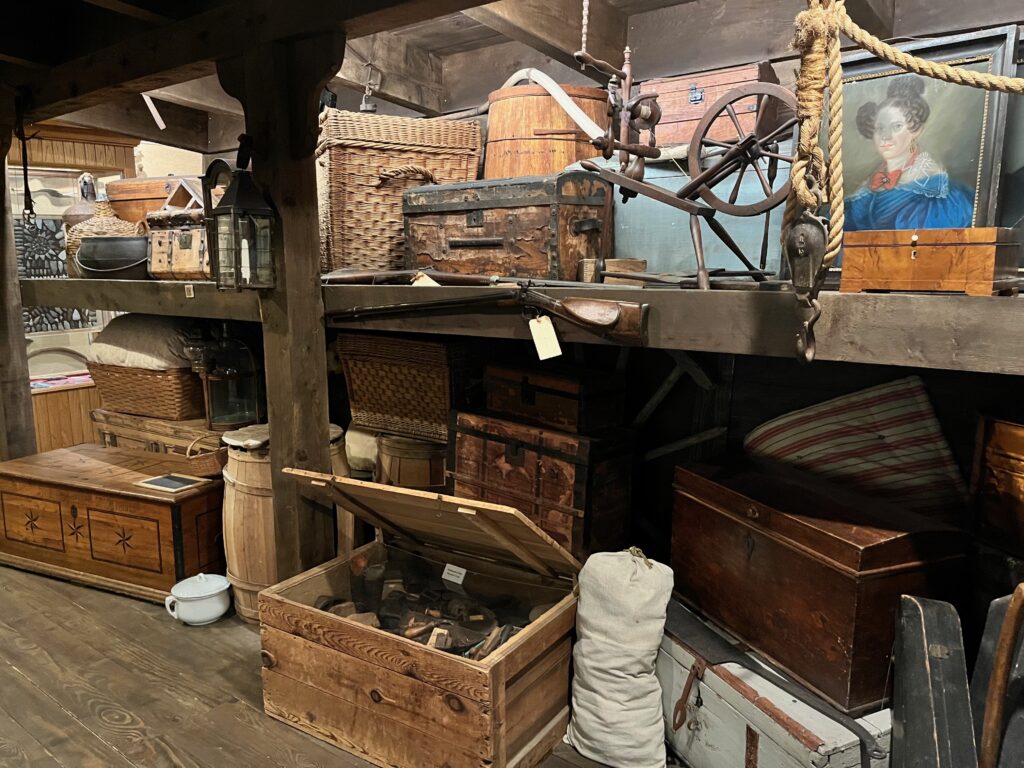
Artifacts from early German settlers fill the rafters at the Sophienburg Museum in New Braunfels. Photo by Mark Orwoll
This hospitable place, which became New Braunfels is today the sister city of Braunfels Germany. It’s home to the largest natural springs in Texas and is set between two rivers the Comal and the Guadalupe. (The 2.5-mile-long Comal is the shortest navigable river in the United States or, as they like to say in Texas, the longest shortest river in the world) The next year 125 of the pioneers would carry on toward the original land grant and eventually found Fredericksburg.
Prince Carl, alas, was less than astute as a businessman. He didn’t keep financial records his dealings were done on promises and loans in no time, the Adelsverein expedition was broke at one point, the youthful prince was detained for debts until he was bailed out by his replacement John O. Meusebach. Ultimately, Carl returned to Germany leaving behind a financial mess.
Many of Prince Carl’s belongings are on display at the Sophienburg, a modern repository of German-Texas culture open to the public, on high ground overlooking the town of New Braunfels. Historical displays about daily life through the years will appeal to families including Carl’s royal seal of Braunfels his sword, and a complicated cast-iron trunk that served as a safety deposit box for the society’s papers.
New Braunfels at the Crossroads
Despite financial hardships, New Braunfels became the crossroads for subsequent waves of German immigrants in the new land. Some 6,000 of them moved to Texas between 1845 and 1850, which led to New Braunfels becoming (for a brief time) the fourth-largest town in Texas.
Even 180 years after Prince Carl’s early expedition, the Germans still keep coming to the Hill Country, and to New Braunfels in particular. With its turn-of-the-century architecture, historic structures, and German-focused cuisine, the town is a natural destination for German tourists as well as for immigrants looking for a new life in Texas.
In the heart of New Braunfels, the Alpine Haus restaurant is set in an original pioneer cabin (circa 1850 and since expanded). The restaurant is 100% German Diners sway to the background polka music, drink German beers and wines, and enjoy schweinebraten and hühnerbrust geschnetzeltes.
One of the servers, Toby (short for Tobias), is from southern Germany. It was in Texas that he met the woman he would wed a German from Cologne. “We had to move all the way to Texas to meet and get married!” he laughs.
One diner ordered the rinder roulade, so large as to be terrifying a thinly cut steak pounded to within an inch of its life folded over and stuffed with bacon onions, pickles, and German mustard under gravy served with red cabbage, spätzle, and potato dumplings, along with a Trappistes Rochefort Belgian ale with a stupefyingly strong 11.3 percent alcohol content. Elsewhere on the menu (which is likely not approved by Weight Watchers) are schnitzel, goulash, sausage platters, and for dessert, strudel and Black Forest cake. Ach du lieber!
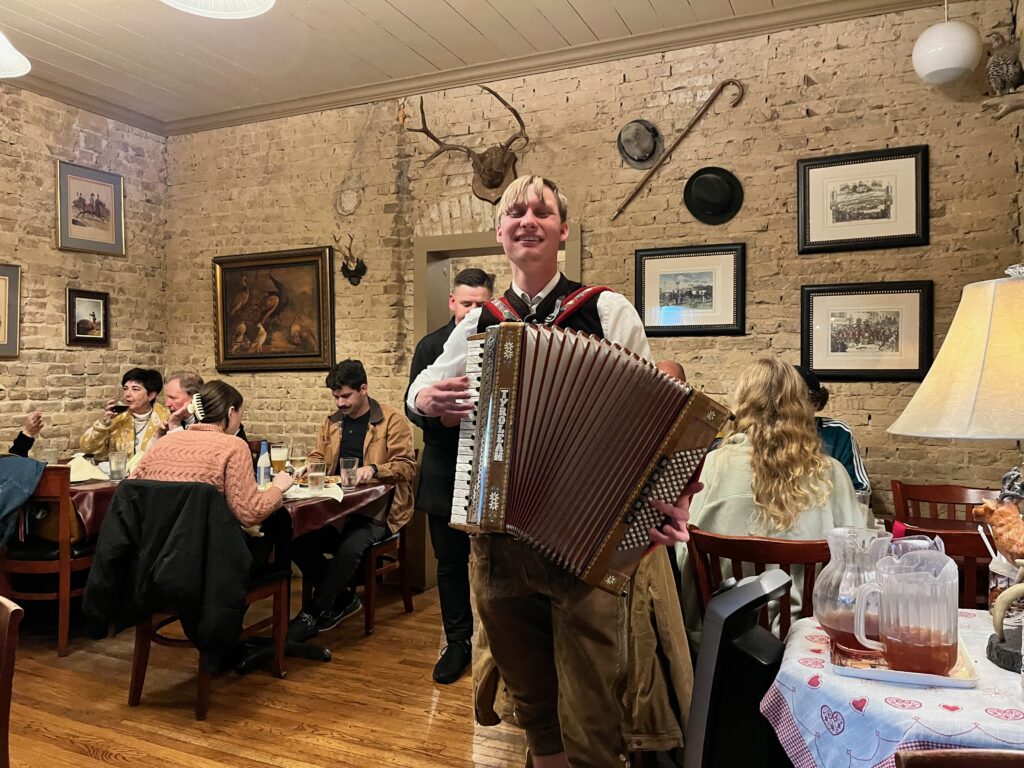
German cuisine and polka music are always on the menu at the Alpine Haus in New Braunfels. Photo by Mark Orwoll
Adding atmosphere was traditional German accordion music played by Isaak Klaus a young blond man wearing traditional lederhosen. Klaus’s forebears immigrated in 1850 Klaus is proud of his German heritage he has visited the family’s ancestral hometown, studied the language and now leads a polka band, the Lederhosen Junkies, when he isn’t serenading diners at the Alpine Haus.
“I do this to keep the German tradition alive,” he says. “My German friends call me ee-sock,” he winks. “Everyone else calls me eye-zuck.” Like a good German, he teaches Sunday school at the local Lutheran church.
At Krause’s Café (pronounced krau-sees) one block away old maps of Germany decorate the walls. Just beyond the entrance is a roofed, dog-friendly beer garden. On the menu bratenasche (local bratwurst, sauerkraut, onions, and peppers on pita bread with spicy mustard), a wild-game sampler, sausage and bier cheese with candied jalapeños, and loaded kartoffel poppers (fried, shredded potato fritters topped with cheese, bacon, sour cream, and green onion).
Susi Vogel is Krause’s manager. She was born in a village just outside Dresden and relocated to the United States in 2006 to manage a German restaurant in Florida. She came to Krause’s in 2020 after falling in love with the café’s authentic German vibe.
“It’s like a little gasthaus in Germany” she says, Really cozy. In the mornings, you still have the old Germans coming in and many of them still speak Texas-German. But I can hardly understand them! New Braunfels has kept the German heritage alive more than in Fredericksburg. That’s more for tourists.”
Ouch! Them’s Fighting Words
Fredericksburg is a mandatory stop on any Hill Country itinerary. The 179-year-old settlement is at the center of the burgeoning Hill Country wine region, whose wineries welcome visitors for tastings. It stages the second-biggest Oktoberfest in Texas (the biggest, called Wurstfest, is in New Braunfels). Its restaurants range from traditional Bavarian to cutting-edge pizza to Texas-forward dishes by Michelin-starred chef Michael Fojtasek at the new full-service Albert Hotel.
A friendly rivalry exists between Fredericksburg and New Braunfels. One might argue for example that Fredericksburg’s Pioneer Museum with its original buildings spread throughout town is more family-friendly than the research-intensive Sophienburg. But that’s like debating whether Black Forest cake is tastier than apfelstrudel.
Many of the settlers of both Fredericksburg and New Braunfels became so successful that they came into the “big city” of San Antonio to do business. Some had part-time homes in the city or moved there permanently. So many Germans settled south of the Alamo at a dog-leg jog in the San Antonio River that American residents dubbed it Sauerkraut Bend.
Sauerkraut Bend is now the King William Historic District, named for Prussian King Wilhelm. The gracious streets are lined with impressive Italianate villas, Victorian estates, and Greek Revival mansions dating mostly from the 1880s and ’90s. These homes tell a tale of German immigration and in many cases the enormous, hard-won success of those once-humble immigrants. Anton Wulf was a simple merchant Alexander Sartor was a watch repairman Martin Froebel was a wheelwright. Carl H. Guenther was a miller within 10 or 20 years of arriving in the Hill Country, they had climbed the economic ladder and built imposing manors. Several of the homes are open for tours.
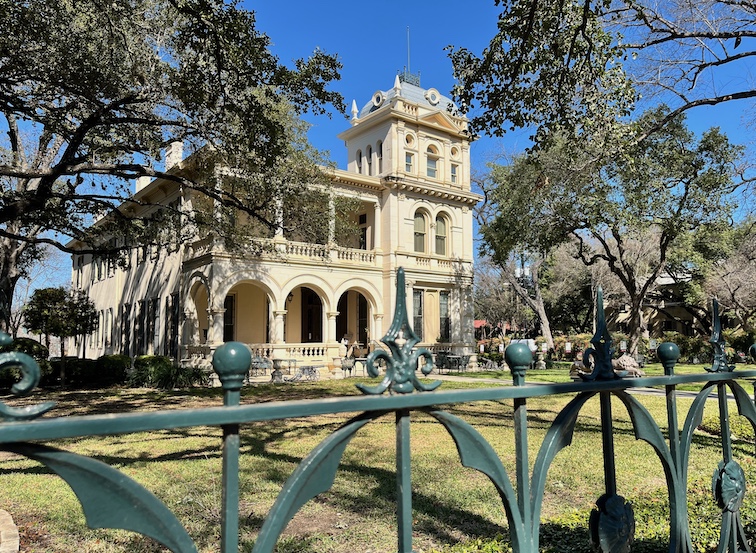
San Antonio was always an anchor for the Hill Country in the 1800s, as it was for the rest of Texas. The booming town was a center for agriculture and ranching as well as a key financial hub in the early days. The city has maintained its low-rise profile but is now a modern productive hub of south-central Texas. Today its primary economic drivers are the military, technology, healthcare, and, especially, tourism.
Ursula’s Ashes
Bill Lyons 86 three-quarters German descended from those settlers. Lyons owns Schilo’s serving Texas-German fare since 1917 and today the oldest restaurant in San Antonio. The place though unassuming is as German as it gets.
“My grandfather owned what’s now the oldest restaurant on the river Casa Rio” Lyons says. The family bought out Schilo’s original proprietors in 1980. But they didn’t change a thing. Schilo’s still has a 1917 vibe a wooden phone booth, cozy banquettes, waiters and waitresses elbowing each other in and out of the kitchen, trophy heads on the paneled walls.
Our daughter will be the fourth generation to run the business” he says. She even brought her three-year-old son to a management meeting! Lyons also appreciates the old-school German waitresses who carried out the day-to-day duties in the dining room. They work hard, know their job, and They don’t mess around.
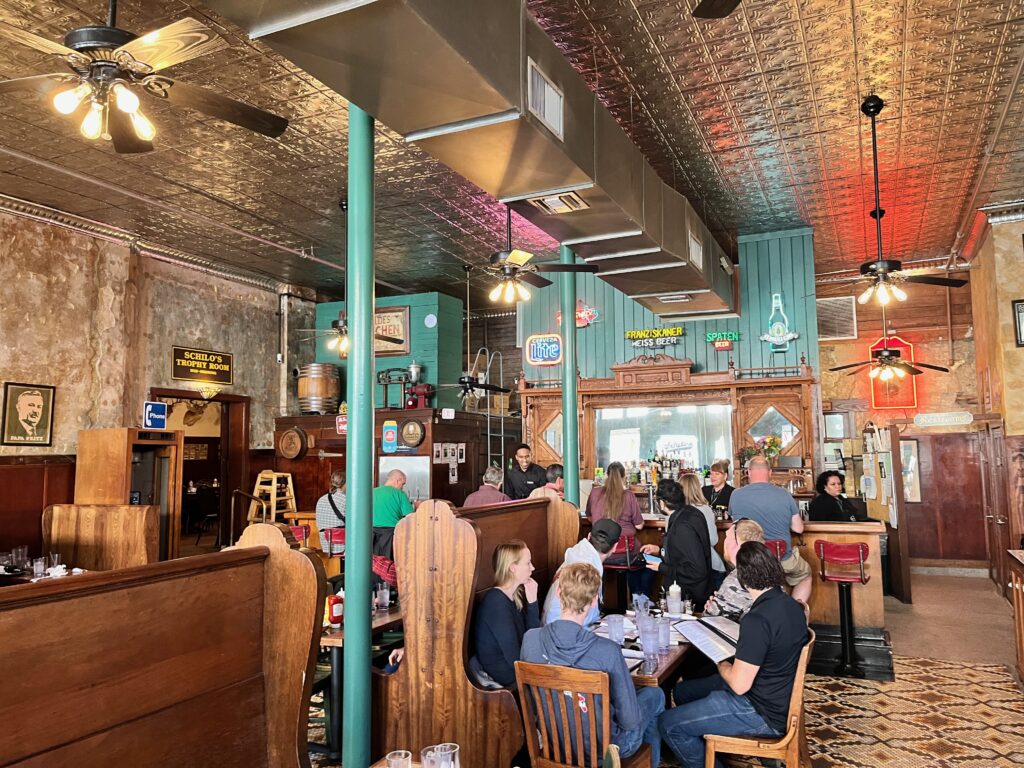
High ceilings, tile floors, and a Texas vibe greet customers at Schilo’s, San Antonio’s oldest restaurant. Photo by Mark Orwoll
“If you wanted a strong woman and a good waitress,” he says wistfully, “it was Ursula. She used to tell the new waitresses to stay out of her way. She’d warn them, this part is where I walk in and out. It’s my autobahn she claimed that a man named Adolf Schicklgruber was her godfather. When she passed away her family wanted to hold the memorial service here at Schilo’s. So we closed early that day placed her turn on the counter over there, and got a pastor to lead the service. And so, next to the root-beer taps and the bakery counter Ursula’s ashes came home.
“We’ve lost all those German ladies” Lyons says, his eyes getting misty. “We had six or seven at one time. Now, they’re all gone.”
The End of an Era
So too is the old dialect fading.
“We speak an old dialect we call Texas-German,” says Evelyn Weinheimer of Fredericksburg’s Pioneer Museum. “Some of us can still speak like our ancestors visitors from Germany today can’t understand us. You can still take lessons here we’re trying to keep it alive, but it’s fading away.”
Today, says historian David Schafer, most kids here don’t grow up speaking German. The last German-language newspaper in the region stopped publishing in 1945. We’re losing part of that heritage.
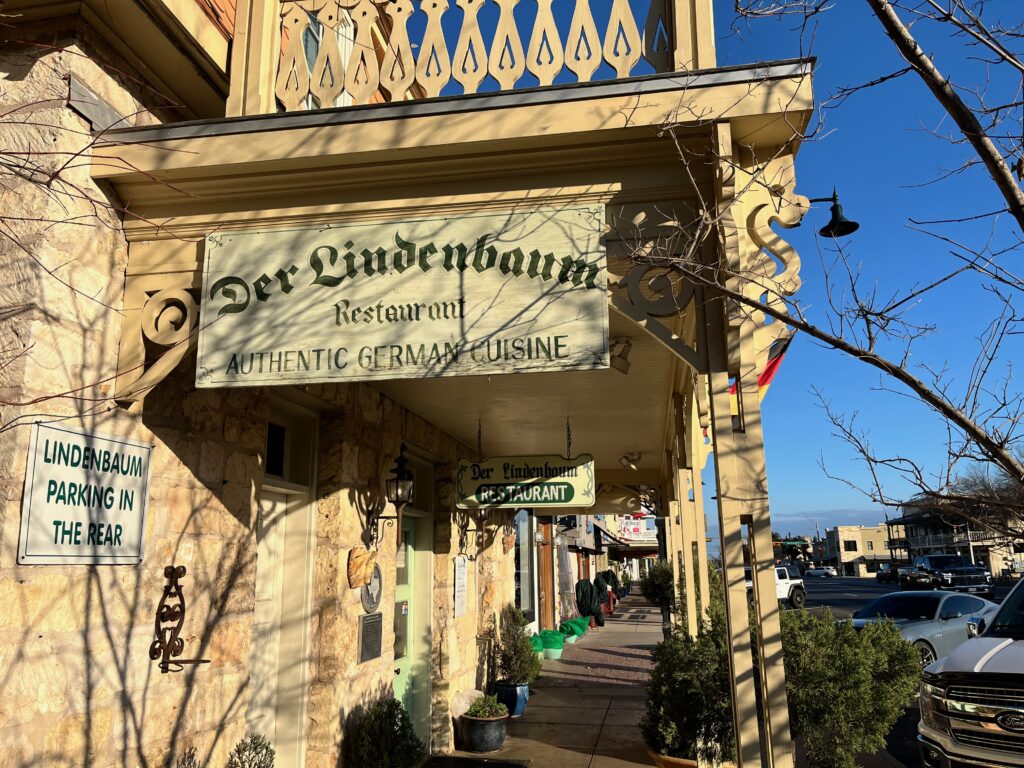
As the sign says, Der Lindenbaum in Fredericksburg serves authentic German cuisine. Photo by Mark Orwoll
Do the museum and the town get a lot of German visitors? We do, said Weinheimer. When they hear about a little German town deep in Texas, they really want to see it and they want to taste the Texas take on German food. There’s a magical feeling here.”
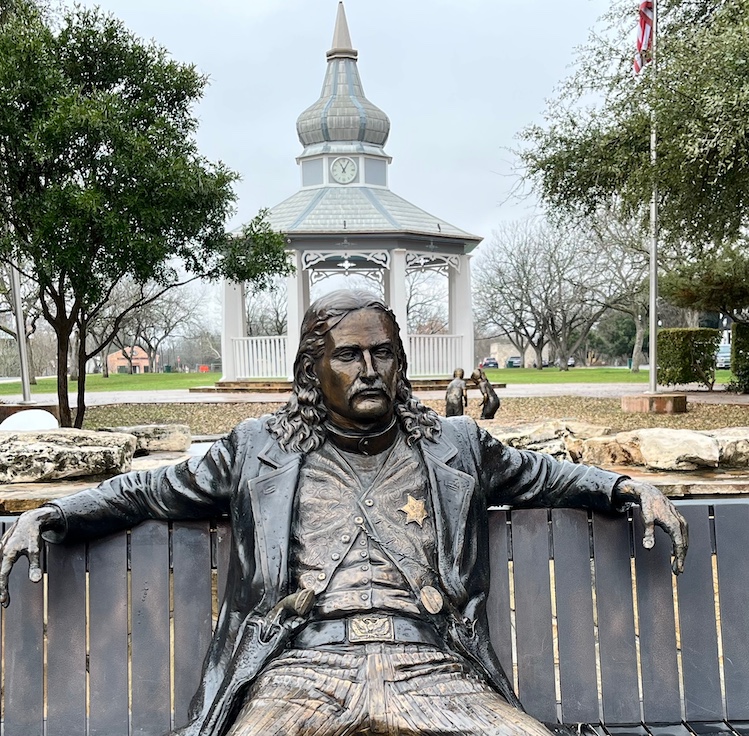
Sheriff Selfie. Visitors to the German hill country community of Boerne (pronounced Bernie) invariably stop and take Instagrammable selfies next to the statue of Western folk hero Wild Bill Hickock. Boerne’s city fathers admit Hickock never came to their city, but they reckon he would have enjoyed it a lot more than Deadwood, South Dakota, where he died from a gunshot playing poker. Photo by Mark Orwoll
Nearly Nirvana
Das Peach Haus is full of raffish Texas charm, a specialty-foods shop and mail-order business going back to 1976. The Wieser family bought 60 acres of farmland just outside downtown Fredericksburg in 1928 and planted 450 peach trees. Today, the Texas Hill Country is famous for its peaches. Their son Mark grew up selling the family’s peaches by the roadside.
“Fredericksburg was funny in those days,” says Wieser. It’s not like what you see today people would drive up to Fredericksburg buy peaches and then go home. It wasn’t until the nineteen-seventies that a bunch of us got together and began talking about tourism.”
That’s when Wieser, a son of German immigrants bought a rickety wood-sided Lone Star Beer warehouse built in 1913. He moved the entire structure to the family farmstead and began selling peaches from the relocated building along with sauces, jams, jellies, and preserves. Today the business thrives and is a popular stop for visitors to Fredericksburg.
“There’s a reason why we’re here, why we stay,” says Wieser. “This is our home this community is wonderful in that it has more givers than takers. It’s certainly not nirvana, by any means, but it’s as close as you can get.”
The German influence from New Braunfels to Fredericksburg is still strong, but how long will it last?![]()
Freelance writer Mark Orwoll is only 19 percent German but felt right at home in the Texas Hill Country. His previous stories for EWNS looked at the demise of Stuckey’s and HoJo’s and how Chinese food became an American staple.

